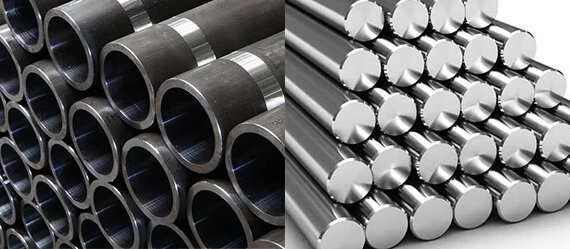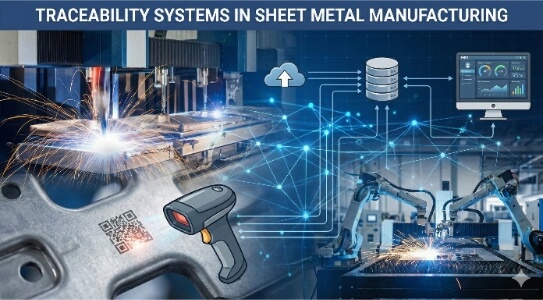Metal fabricators face constant decisions about material selection. Choosing alloy and carbon steel affects project costs, durability, and performance. Wrong material choices lead to wasted money, failed parts, and missed deadlines. But the right choice saves time and creates reliable products that last.
Both alloy and carbon steel have unique strengths. Carbon steel is simple, strong, and cost-effective. Alloy steel, with added elements like chromium or nickel, offers better strength, toughness, and corrosion resistance. Your choice depends on your project’s needs.
Both steels serve different purposes in manufacturing. Let’s examine their unique properties, applications, and cost factors to help you choose your project best.

What Makes Steel “Alloy” or “Carbon” Steel?
Steel is made from iron and carbon, but the difference is added elements. Carbon steel has only iron and carbon. The amount of carbon changes its properties. Low-carbon steel is soft, while high-carbon steel is hard and strong.
Alloy steel has extra elements like chromium, nickel, or manganese. These elements improve strength, toughness, and corrosion resistance. The added elements make alloy steel more versatile but also more expensive.
Alloy Steel Overview
Alloy steel is a versatile material with added elements to enhance its properties. Let’s break down what it is, what makes it unique, and where it’s used.
What is Alloy Steel?
Alloy steel is made from iron and carbon, with other elements added. These added elements improve the steel’s strength, toughness, and resistance to wear and corrosion. The exact mix of elements used depends on the type of alloy steel and its intended use.
Key Elements Added to Alloy Steel
Some common elements added to alloy steel include:
- Chromium: Helps resist rust and corrosion.
- Nickel: Increases strength and toughness.
- Molybdenum: Improves resistance to heat and wear.
- Vanadium: Increases hardness and strength.
- Manganese: Improves hardness and tensile strength.
Types of Alloy Steel and Their Applications
Alloy steel can be divided into low-alloy steel and high-alloy steel. The difference between them lies in the amount of alloying elements used.
Low-Alloy Steel
Low-alloy steel contains less than 5% of alloying elements. It offers a good balance between strength, hardness, and resistance to wear, making it suitable for everyday applications. You’ll find it in construction materials, automotive parts, and machinery components.
High-Alloy Steel
High-alloy steel has more than 5% alloying elements. It provides much better resistance to heat, corrosion, and wear, making it ideal for more demanding jobs. It’s often used in aerospace, tools, turbines, and high-performance equipment.
Benefits of Using Alloy Steel
Alloy steel has several key advantages:
- Greater Strength: The added elements make the steel more substantial and complex.
- Better Resistance to Corrosion: It resists rust and corrosion better than plain carbon steel.
- More Durability: Alloy steel lasts longer because it’s more wear and tear-resistant.
- Improved Toughness: It can handle extreme temperatures and high pressure.
Common Uses of Alloy Steel
Alloy steel is used in many industries that require durable and high-performance materials. Here are some common uses:
- Automotive Parts: Things like gears, engine parts, and crankshafts.
- Construction: Steel beams, bars, and pipes are used in building structures.
- Machinery: Parts that need to resist wear and handle high stress.
- Aerospace: Components for planes and space equipment must be strong and light.
- Oil and Gas: Equipment used in drilling and transporting oil.

Carbon Steel Overview
Carbon steel is one of the most widely used manufacturing materials. It’s made from iron and carbon, and the amount of carbon in the steel determines its properties, such as strength, hardness, and ductility.
What is Carbon Steel?
Carbon steel is made by combining iron and carbon with little or no other elements. The amount of carbon in the steel affects its strength and hardness. The more carbon it has, the stronger it becomes, but it can also become less flexible. Carbon steel is widely used because it’s affordable and versatile.
Types of Carbon Steel
Carbon steel comes in three main types, each with its characteristics based on the amount of carbon added.
Low Carbon Steel
Low-carbon steel has less than 0.3% carbon. It’s soft, easy to shape, and weldable. It’s often used in construction, automotive panels, and wire products.
Medium Carbon Steel
Medium carbon steel has between 0.3% and 0.6% carbon. It’s stronger than low-carbon steel but still retains good ductility. It’s often used in parts like gears, axles, and shafts.
High Carbon Steel
High-carbon steel contains 0.6% to 2.1% carbon. It’s robust and rigid but less ductile, meaning it can be brittle. This type is often used in tools, knives, and cutting blades.
Benefits of Using Carbon Steel
Carbon steel offers several benefits:
- Cost-Effective: It’s cheaper than other types of steel.
- Good Strength: It can be made strong enough for many industrial applications.
- Versatile: With different types available, it can be used for various products.
- Easily Shaped: It can be easily cut, welded, and formed into different shapes.
Common Uses of Carbon Steel
Carbon steel is used in many industries, from construction to manufacturing. Here are some common uses:
- Construction: Steel beams, plates, and other structural materials.
- Automotive: Parts like frames, axles, and alloy wheels.
- Machinery: Components like gears, shafts, and pipes.
- Tools: Cutting tools, knives, and blades.
Alloy Steel vs Carbon Steel: Key Differences
Choosing between alloy steel and carbon steel depends on their differences. Let’s compare their composition, properties, and costs to help you decide.
Composition and Alloying Elements
- Carbon Steel: Mostly iron and carbon. There are no added elements.
- Alloy Steel: Iron, carbon, and elements like chromium, nickel, or manganese. These additions improve its properties.
Mechanical Properties Comparison
Strength and Hardness
- Carbon Steel: Strong but less so than alloy steel. Hardness depends on carbon content.
- Alloy Steel: Stronger and more complex due to added elements. Handles heavy loads and stress better.
Toughness and Ductility
- Carbon Steel: Tough but can be brittle at high carbon levels. Low-carbon steel is more ductile.
- Alloy Steel: Tougher and more resistant to cracking. Better for high-impact applications.
Cost Comparison
Material Costs
- Carbon Steel: Cheaper. Ideal for budget-conscious projects.
- Alloy Steel: More expensive due to added elements. It costs more upfront but offers better performance.
Processing Costs
- Carbon Steel: Easier to machine, cut, and weld. Lower processing costs.
- Alloy Steel: Harder to work with. It may require special tools or techniques, increasing processing costs.
Performance and Durability Comparison
Performance and durability are critical when choosing steel. Let’s see how alloy and carbon steel handle stress, corrosion, and temperature.
How do Alloy Steel and Carbon Steel Perform Under Stress?
- Carbon Steel: Strong but can fail under extreme stress. High-carbon steel is brittle and may crack under heavy loads.
- Alloy Steel: Handles stress better. Added elements like chromium and nickel improve strength and toughness. It’s ideal for high-stress applications.
Corrosion Resistance: Which Steel Holds Up Better?
- Carbon Steel: Prone to rust and corrosion. It needs coatings or treatments to resist corrosion.
- Alloy Steel: Better corrosion resistance. Elements like chromium form a protective layer, making it suitable for harsh environments.
Impact of Temperature on Alloy Steel and Carbon Steel
- Carbon Steel: Loses strength at high temperatures. Not ideal for high-heat applications.
- Alloy Steel: Performs well at high temperatures. Elements like molybdenum improve heat resistance, making it suitable for aerospace and automotive uses.
This table should provide a quick reference for understanding the main differences between alloy steel and carbon steel:
| Feature | Alloy Steel | Carbon Steel |
|---|---|---|
| Composition | Contains additional elements like chromium, nickel, and molybdenum. | Primarily made of iron and carbon. |
| Strength and Hardness | Higher strength and hardness due to added elements. | Moderate strength, less hard than alloy steel. |
| Toughness and Ductility | Can be less ductile, especially in high-carbon alloys. | More ductile and flexible, especially in low-carbon forms. |
| Corrosion Resistance | Better corrosion resistance due to alloying elements. | More prone to corrosion without protective coatings. |
| Temperature Resistance | Performs better in high-temperature environments. | Loses strength at higher temperatures. |
| Cost | More expensive due to added elements and complex processing. | Generally cheaper and easier to process. |
| Common Uses | Aerospace, tools, high-performance machinery. | Construction, automotive parts, general manufacturing. |
Choosing the Right Steel: Factors to Consider
Picking the correct steel depends on your project’s needs. Let’s look at when to choose carbon steel and when to go for alloy steel.
When to Choose Carbon Steel?
Carbon steel is a good choice when the cost is a key factor, and the application doesn’t require high performance. It’s ideal for projects that need essential strength, flexibility, and ease of processing. Consider carbon steel if:
- Your project doesn’t need high resistance to corrosion or heat.
- You’re working with moderate loads and pressures.
- The application is in construction, automotive parts, or general manufacturing.
- You want an affordable option without sacrificing too much strength or toughness.
When to Choose Alloy Steel?
Alloy steel should be your choice if your project demands higher strength, better wear resistance, or performance in extreme conditions. The added elements make it suitable for more demanding applications. Opt for alloy steel if:
- You need superior corrosion resistance or high-temperature performance.
- The product will experience heavy loads, stress, or high-pressure environments.
- The application involves tools, aerospace, high-performance machinery, or industrial equipment.
- Durability and longevity in harsh environments are crucial to the project’s success.
Your choice depends on your project’s specific requirements. To make the best decision, consider factors like strength, corrosion resistance, temperature, and budget.
How to Identify Alloy Steel vs Carbon Steel?
Identifying alloy steel and carbon steel can be tricky. Let’s look at visual clues and testing methods to help you tell them apart.
Visual Indicators
- Carbon Steel: Often has a dull, matte finish. It may show signs of rust if not coated.
- Alloy Steel: Sometimes has a shinier or smoother surface due to added elements like chromium. It may also have a more uniform appearance.
Visual clues alone aren’t always reliable. Testing is often needed for accurate identification.
Common Testing Methods
Spark Test:
- Carbon Steel: Produces long, straight sparks with few bursts.
- Alloy Steel: Sparks may be shorter and have more bursts or forks due to added elements.
Magnetic Test:
- Carbon and alloy steel are magnetic, but this test can help rule out non-ferrous metals.
Chemical Analysis:
- A lab test can identify the exact composition of the steel. This is the most accurate method.
Hardness Test:
- Alloy steel is often more complicated than carbon steel. A hardness tester can measure this difference.
Conclusion
Depending on your project’s needs, you can choose between alloy steel and carbon steel. Carbon steel is cost-effective and works well for moderate applications, while alloy steel offers enhanced strength, durability, and performance in demanding conditions.
If you need a basic, affordable material for everyday use, carbon steel is the way to go. However, alloy steel is better if your project requires superior corrosion resistance, high strength, or performance in extreme temperatures.
Need custom sheet metal fabrication for your project? Contact us today! We specialize in turning your ideas into high-quality, precise sheet metal products. Contact us now for a quote or to discuss your requirements!
Hey, I'm Kevin Lee

For the past 10 years, I’ve been immersed in various forms of sheet metal fabrication, sharing cool insights here from my experiences across diverse workshops.
Get in touch

Kevin Lee
I have over ten years of professional experience in sheet metal fabrication, specializing in laser cutting, bending, welding, and surface treatment techniques. As the Technical Director at Shengen, I am committed to solving complex manufacturing challenges and driving innovation and quality in each project.




